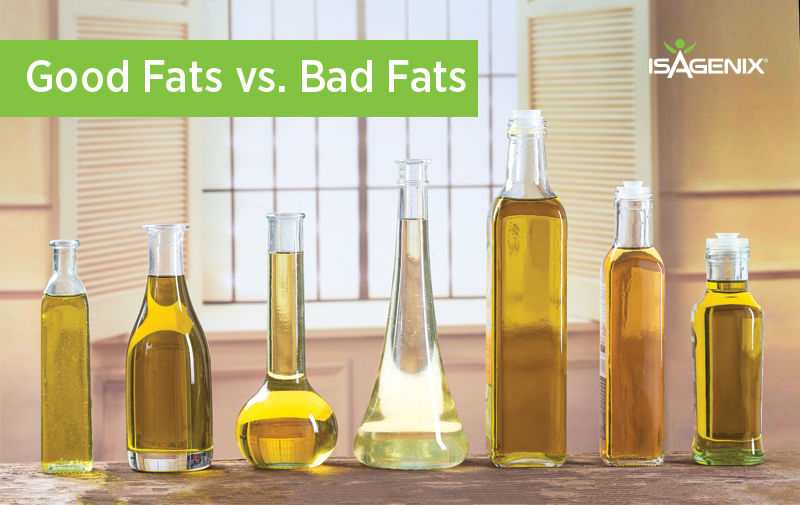The Facts Behind The Fats in Your Diet
November 1, 2017,
Rebecca Haresign

Getting adequate amounts of fat is an important part of a healthy, balanced diet. Although there are some types of fat you want to avoid or consume sparingly, our bodies do require some fat.
Fat is a source of the essential fatty acids that your body can’t make itself. Fat helps your body to absorb the fat-soluble vitamins A, D, E, and K. Fat is also a source of energy, providing 9 calories per gram. This is more calories than the other macronutrients provide, as carbohydrate and protein each provide 4 calories per gram.
Types of fat
Fat is made up of different building blocks, known as fatty acids. The structure, length and saturation of these fatty acids determines their health effects (1). A typical diet is made up of different types of fat –saturated and unsaturated fat. Most foods contain a mixture of both types, and we tend to refer to foods as being high in saturated or unsaturated fats depending on the type of fat they are predominantly made up of.
Consuming fat in excess of energy requirements can lead to weight gain over a period of time. This can increase the risk of other health conditions (2). For example, too much saturated fat can increase the amount of cholesterol in your blood. A high cholesterol level can increase your risk of developing coronary heart disease (3).
How much fat do we need in the diet?
We are recommended to get no more than 35% dietary energy from fat. For an average female, this equates to no more than 78 grams of total fat daily. But the type of fat we are consuming is just as important as the total amount. Of this 35%, it’s recommended that saturated fat makes up no more than 11% food energy (4).
Harmful effects of saturated fatty acids
Saturated fat can increase the amount of a type of cholesterol known as low density lipoprotein (LDL)-cholesterol in our blood. This type of cholesterol is often called ‘bad’ cholesterol as too much of this type of cholesterol in our blood can cause fatty material to build up in the walls of our blood vessels and cause them to narrow. Good cholesterol, high density lipoprotein (HDL)-cholesterol, carries the LDL-cholesterol to the liver to be broken down, so that too much doesn’t build up in our blood (5, 6).
Health effects of unsaturated fatty acids
There are two types of unsaturated fatty acids – monounsaturated and polyunsaturated. Unsaturated fatty acids can help to maintain healthy cholesterol levels, including reducing levels of LDL cholesterol. Current nutrition guidelines are to partially replace saturated fatty acids with unsaturated fatty acids in the diet to maintain healthy cholesterol levels and cardiovascular health. In addition to helping to maintain healthy cholesterol levels, polyunsaturated fats also provide us with essential fatty acids, which the body can’t make itself including omega-3 and omega-6 (1, 7-8).
How can I make healthier choices in my third meal?
- Use plant-based oils and spreads, such as olive, rapeseeds or sunflower oils instead of butter, lard, or coconut oil. You could also try using a spray oil to control the amount of oil you’re adding to your cooking.
- Include oily fish such as salmon, mackerel or fresh tuna once per week. When you’re preparing meat, trim the excess fat and opt for lean meats such as chicken, turkey or fish.
- Try healthier methods of cooking, such as grilling, baking, steaming, boiling or poaching instead of deep frying.
- Choose lower fat dairy products when you have the option, e.g. skimmed milk, reduced fat cheese, or low fat yogurt.
Fats in Isagenix products
Fats are crucial to so many functions in the body. Different fats offer different advantages, whether it’s supplying monounsaturated fats or essential fatty acids. The variety of fats supplied through Isagenix products such as our nutritionally balanced IsaLean™ Shake, helps to ensure you receive the right amount of fats in the right balance.
References
- Lunn J, Theobald HE. The health effects of dietary unsaturated fatty acids. Nutr Bull 2006;31:178-224
- NHS Choices. Obesity. Available at: https://www.nhs.uk/Conditions/Obesity/Pages/Introduction.aspx (accessed 26th October 2017)
- British Heart Foundation. Fats explained. Available at: https://www.bhf.org.uk/heart-health/preventing-heart-disease/healthy-eating/fats-explained (accessed 26th October 2017)
- Public Health England. Government Dietary Recommendations. Available at: https://www.gov.uk/government/uploads/system/uploads/attachment_data/file/618167/government_dietary_recommendations.pdf (accessed 26th October 2017)
- Mason P, Porter SC, Berry SE, Stillman P, Steele C, Kirby A, Griffin BA, Minihane AM. Saturated fatty acid consumption: outlining the scale of the problem and assessing the solutions. Nutr Bull 2009;34:74-84
- British Heart Foundation. High cholesterol. Available at: https://www.bhf.org.uk/heart-health/risk-factors/high-cholesterol (accessed 26th October 2017)
- COMA (Committee on Medical Aspects of Food Policy). Nutritional Aspects of Cardiovascular Disease. Department of Health Report on Health and Social Subject. 1994. No. 46, HMSO, London.
- NHS Choices. Fat: the facts. Available at: https://www.nhs.uk/Livewell/Goodfood/Pages/Fat.aspx (accessed 26th October 2017)




